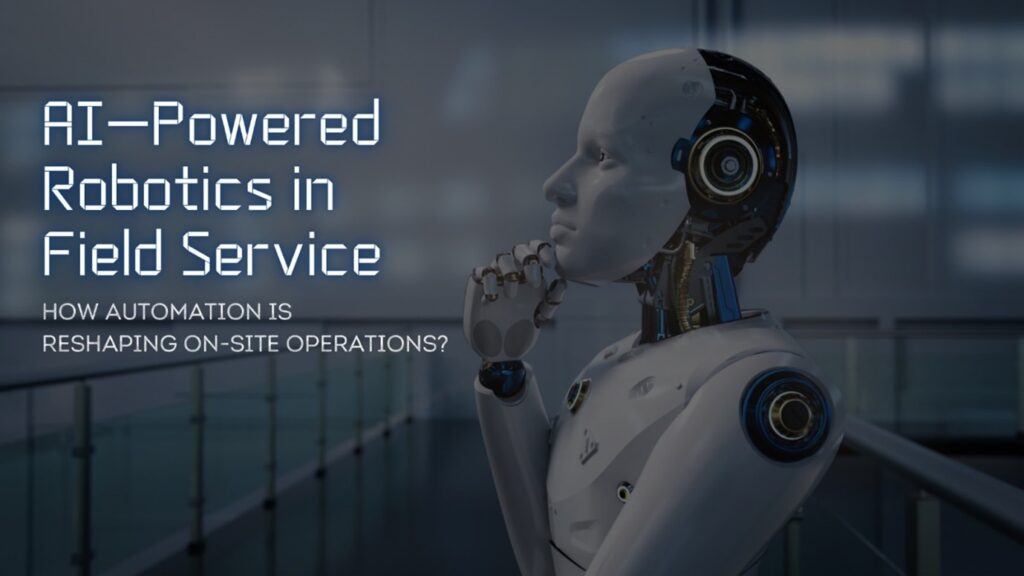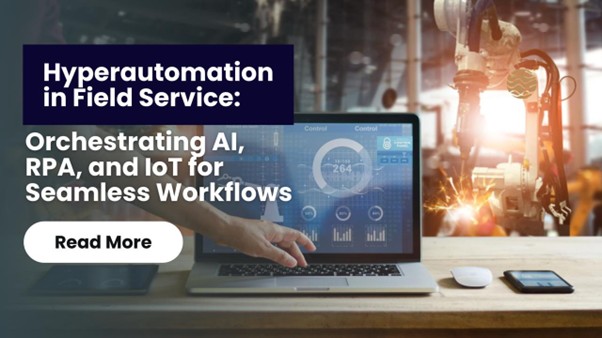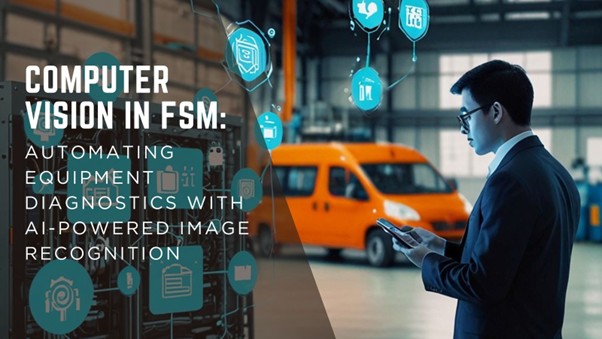AI-Powered Robotics in Field Service: How Automation is Reshaping On-Site Operations?

Quick Summary
AI in robotics is causing a significant shift in field service management, as inspections, care, and decisions are automated. Automating field service makes technicians more productive, reduces the risk of operational issues, and enhances customer satisfaction. It affects both autonomous drones and predictive maintenance bots. This blog examines how robotics, driven by AI and integrated with platforms like FieldEZ, revolutionizes on-site operations. It occurs through machine learning, real-time data, and seamless human-robot interaction.
AI-Driven Robotics and Automated Field Service Solutions Revolutionize Efficiency, Safety, and Customer Satisfaction in On-Site Work!
The field service industry is undergoing significant changes. Businesses now prefer using AI-driven robots over manually inspecting all areas for potential hazardous situations. These machines can collect current data and analyze it to help make better decisions. With such reports, companies can address problems at an early stage, before they escalate.
One of the most significant changes happening today is powered by automated field service solutions. They utilize robotics, AI, and predictive analytics in conjunction to empower technicians. As a result, drones and collaborative robots are now crucial in many fields of service delivery. Discover how the FieldEZ solution aligns with the evolving trends in our industry.
Snapshot
- 30–40% productivity boost for techs equipped with AI and mobile tools (Source)
- 78% of top-performing service firms use AI; 83% use automation (Source)
- Robotics-as-a-Service (RaaS) market expected to grow from $16 B (2025) to $125 B by 2034 (Source)
Why AI-Driven Robotics Is Crucial in Modern Field Service?
AI-powered robots deliver speed, accuracy, and repeatability in environments that are risky or complex. Enhanced by algorithms and sensors, they tackle tasks like infrastructure inspection, hazardous material handling, and real-time diagnostics.
Key benefits:
- No more human errors or putting them at risk
- Around-the-clock productivity
- Consistent, standardized data gathering
- Faster issue detection and resolution
- Reduced operational costs over time
Market insights:
- The AI robots market soared from $14.45 B (2024) to $17.39 B (2025), projected to hit $33.6 B by 2029 at a CAGR of 18% (Source)
- Robotics-as-a-Service (RaaS) market expanding rapidly: $16 B in 2025 → $125 B by 2034 (25.5% CAGR) (Source)
These trends highlight a clear shift toward subscription-based robotics over ownership—a model that aligns with scalable field service deployment.
Key Use Cases: From Drones to Cobots
From aerial inspections to collaborative robotics (Cobots), AI-driven field technologies are transforming on-site service operations, offering enhanced accuracy, safety, and productivity without relying on future-dependent tools like augmented reality (AR).
A. Autonomous Inspection Drones
With the help of AI, drones safely handle examinations of hard-to-reach places, helping to secure technicians and enhance the precision of findings.
- Real-time thermal and visual imaging
- Automated flight path execution
- Edge AI for onboard data processing
B. Predictive Maintenance Robots & RaaS Tools
Smart sensors and AI models collaborate to predict asset failures, enabling preemptive field service interventions and reducing unplanned downtime.
- IIoT-enabled condition monitoring
- Machine learning-based fault prediction
- Scheduled alerts for proactive service
C. Collaborative Robots (Cobots)
Cobots assist field workers in repetitive or risky tasks, boosting operational precision while ensuring human-robot safety and ergonomic support in real-world environments.
- Force-limited actuation for safety
- Multi-axis manipulation and control
- Built-in sensors for spatial awareness
D. Robotic Process Automation (RPA)
FieldEZ’s automation tools streamline administrative workflows, including scheduling, dispatch, and reporting, thereby accelerating decision-making and reducing manual errors in field service management.
- Intelligent technician dispatching
- Automated invoicing and reporting
- Backend data reconciliation
These use cases demonstrate how AI-driven robotics and automated field service solutions are already delivering measurable impact, enhancing technician safety, operational efficiency, and asset reliability, without requiring future technological advancements.
Technological Foundations Enabling Intelligent Field Service
AI-powered robotics is becoming increasingly widespread in field service due to the integration of IoT, machine learning, and 5G. It enables faster, more efficient, and autonomous operations.
|
Component |
Role in Field Service |
|
IoT Sensors |
Provide real-time data (vibration, humidity, temperature, GPS) for robots and AI systems. |
|
Edge Computing |
Instant local processing—no delays or connectivity issues |
|
5G/Connectivity |
Enables real-time control and remote collaboration |
|
Machine Learning |
Detects patterns and predicts maintenance needs |
By integrating automated field service solutions and platforms, such as FieldEZ, with robotic technologies, we can optimize missions, dispatch robots, and provide seamless AI-guided assistance.
Metrics & Business Impact of Automation
Assessing the actual effects of robotic and automated field service solutions depends on looking at their performance scores. It demonstrates that automation can enhance the team’s productivity, expedite their response times, and lower their expenses.
- Productivity increase: AI-powered mobile tools improve technician productivity by 30–40%. It enables faster issue resolution, fewer repeat visits, and smart resource allocation. (Source)
- Agility boost: 90% of top-performing field service organizations report improved response times. This happens due to real-time visibility, intelligent dispatch, and proactive service strategies. (Source)
- Workflow automation: 83% of service leaders use workflow automation to streamline scheduling, work orders, invoicing, and reporting. This results in smoother technician workflows and reduced admin overhead. (Source)
- Uptime improvement: AI-powered predictive maintenance and robotics help increase equipment uptime by 10–20%. It significantly reduces costly unplanned downtime. (Source)
These metrics confirm that integrating AI-driven robotics and automated field service solutions delivers measurable improvements. It includes heightened responsiveness, streamlined workflows, and productivity gains, fueling better outcomes for technicians and customers.
Return on Investment:
- Up to 12% savings over scheduled repairs, 30% maintenance cost reduction (Source)
- Robotics shift reduces asset failures and improves service success
Together, these results boost customer satisfaction, safety, and profitability.
Challenges & Strategic Considerations
While AI-driven robotics offers immense promise, organizations must overcome integration, investment, security, and workforce challenges to deploy automated field service solutions effectively and sustainably.
A. Integration Complexity
- Robotic systems can integrate with FieldEZ workflows for dispatch, tracking, and analytics
- Ensuring compatibility via APIs, SDKs, or IoT standards
B. Investment & Ownership Models
- RaaS allows trial initiatives without heavy capital investments
- Enables scalability—from a single drone/autonomous vehicle/robot to fleet-wide deployment
C. Data Security & Privacy
- Robots collect sensitive site data
- Compliance with standards (e.g., GDPR) and secure channels is critical
D. Workforce Adaptation
- Upskilling in robotics and AI is essential
- FieldEZ mobile apps with AR enable technician support without learning complex manual systems
Addressing these strategic hurdles ensures that FieldEZ customers can adopt automation seamlessly, maximizing value, mitigating risks, and preparing their field teams for future-ready service delivery.
The FieldEZ Advantage: Bringing It All Together
FieldEZ delivers smart, scalable field service automation by integrating AI, IoT, and analytics with:
- Automated dispatch of technicians or robots based on AI scheduling
- Real-time asset tracking via IoT inputs and robotics
- AR-enabled overlays for guided support and remote expert collaboration
- Centralized dashboards combining robotics and human service metrics
Using FieldEZ, companies can implement end-to-end automation—from first incident report to robotic field resolution—with transparent, data-driven workflows.
Conclusion!
Industrial-grade AI-driven robotics and automated field service solutions are no longer optional—they’re mission-critical. They reduce risk, drive cost efficiency, optimize asset uptime, and enhance technician effectiveness. Firms that invest early stand to gain a decisive competitive advantage.
FieldEZ empowers you to orchestrate this transformation. From drone missions to AI-guided inspections, our platform ensures smooth, scalable, and secure integration of robotics. Empower your field operations with intelligent automation—contact FieldEZ today and take the next step into the future.



